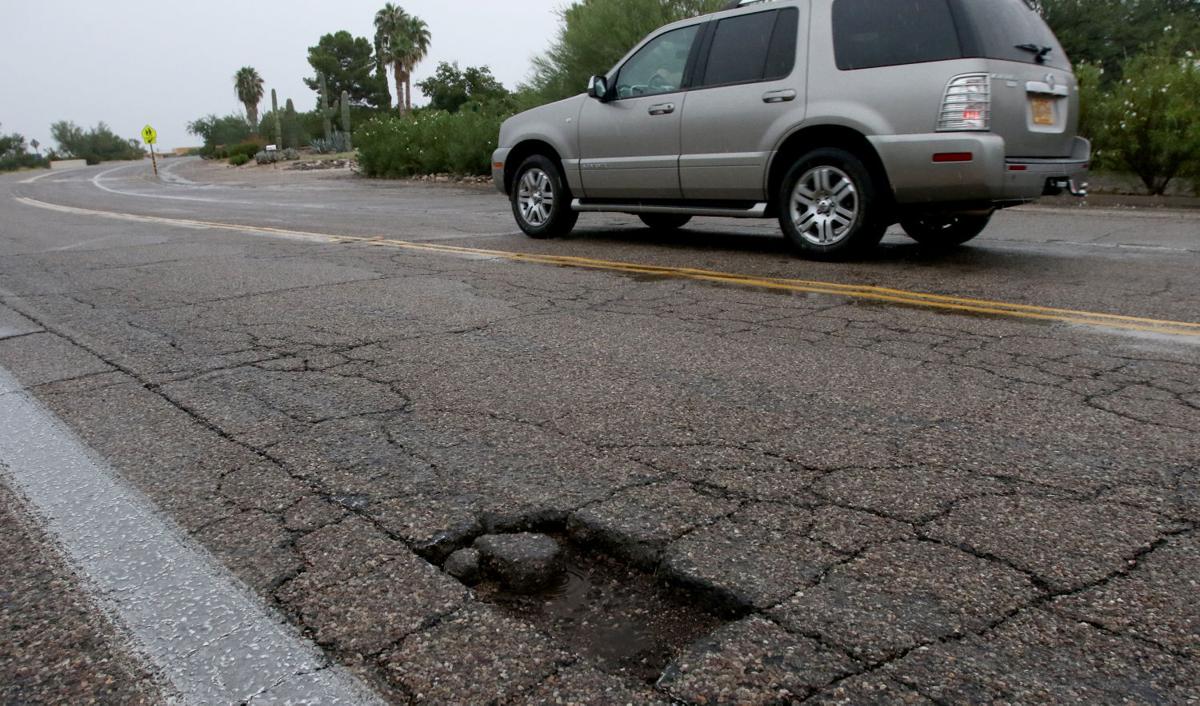Ask almost anyone their thoughts on regional government and you’ll almost certainly hear complaints about the roads.
As much as 60 percent of county-maintained roads have fallen into poor or worse condition, according to Pima County Department of Transportation officials.
Until recently, road conditions in the city of Tucson were just as bad. An ongoing $100 million, voter-approved road-recovery plan has brought miles of city streets up to first-world standards, but more work remains.
A $200 million proposal before voters in November seeks to address the region’s failing roads. Listed as Proposition 425 on the seven-question bond election, the proposal would use $160 million for pavement preservation, $30 million toward the proposed Sonoran Corridor project and $10 million to build roadways in UA Tech Park.
“We’re not 100 percent sold on bonding for road repairs,” said Ramon Gaanderse, executive director at Arizona Transportation Builders Association. “But we have had issues at the federal and state levels that have forced us locally to find solutions.”
Gaanderse said his association board supports the bond package, but added that longer-term funding proposals for transportation-funding options should be explored.
Bond opponent Ginny Crawford agrees regional roads need repairs, but doesn’t want to borrow money to get the job done.
“Our roads are awful and need fixing,” Crawford said. “We have the 1997 HURF bond sitting with $77 million still in it.”
She said the county should use the money that voters already approved before asking to borrow more.
Voters in 1997 approved a $350 million plan to borrow against future Highway User Revenue Fund (HURF) disbursements, which is the money the state collects in gas taxes and distributes to local governments.
County reports show nearly $83 million remains from the 1997 bonds.
Nearly all of the money is spoken for, however.
A $25 million portion belongs to the city for its Broadway widening project, which would add two additional traffic lanes between Country Club Road and Euclid Avenue.
Other funds were incorporated into Regional Transportation Authority Plan projects when voters approved that transportation improvement plan in 2006. The money will be spent according to RTA schedules, which has projects planned through 2026.
If voters approve Prop. 425, the money would be disbursed throughout the region based on each jurisdiction’s share of the overall net assessment.
Marana Mayor Ed Honea opposes all the bond questions and said he’s concerned the county would shortchange the town, given the opportunity.
“They don’t have to give you the money,” Honea said.
The mayor said he thinks language in the recently passed bond-implementation ordinance would allow the county to block funds if the jurisdictions already have “programmed” specific road-repair plans.
“Every single road in the Town of Marana from major thoroughfares to neighborhood streets is on our five-year capital improvement plan,” Honea said, adding the county could declare those roads ineligible for bond funding.
Pima County Administrator Chuck Huckelberry disagrees.
“That’s not correct,” Huckelberry said. “What roads they spend it on is their choice.”
Bond funding would be limited to expenses directly related to road-repair work, not for design or management purposes.
Huckelberry also said the money cannot be used as a replacement for HURF distributions.
“Whatever we’re spending our HURF on we’d have to maintain,” he said.
Each jurisdiction has submitted lists of roads it wants repaired with the 2015 bond funds.
About 374 miles of major arterial streets have been selected for repairs. Neighborhood and local area streets that would be fixed have not yet been determined.
If the bond does pass, the county would establish a seven-member Pavement Preservation Commission to oversee and monitor local road repairs under the bond program.
Each member of the Board of Supervisors would appoint one member; Huckelberry would appoint two.
The proposed $30 million plan for the Sonoran Corridor has been cast as not just a road project but an economic development opportunity.
Bond funds would pay for design and construction of a connection from Interstate 10 and Rita Road running east and west to the under-construction Aerospace Parkway. The road would follow Old Vail Connection Road south of Tucson International Airport.
It’s part of a larger plan to ultimately grab state and federal funding for a highway connection between I-10 and I-19, a plan that has the support of Arizona’s entire congressional delegation.
County leaders say the area would facilitate growth in the warehousing and logistics industries because of the location near major land, air and rail networks.
The areas around the proposed intestate connection stand almost entirely free of development, which county officials hope can help attract additional players in the aerospace and defense industries, such as nearby Raytheon Missile Systems.
“Any city our size or larger has these geographic sectors devoted to that kind of development,” said Mike Varney, president of the Tucson Metro Chamber and a supporter of the bond package. Varney called the roads portion of the proposal “a no brainer.”





